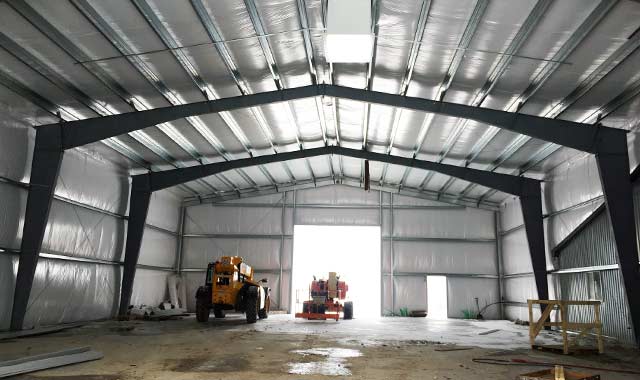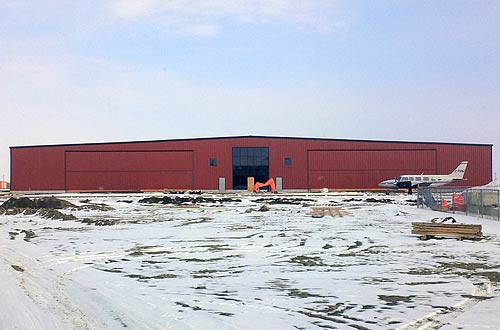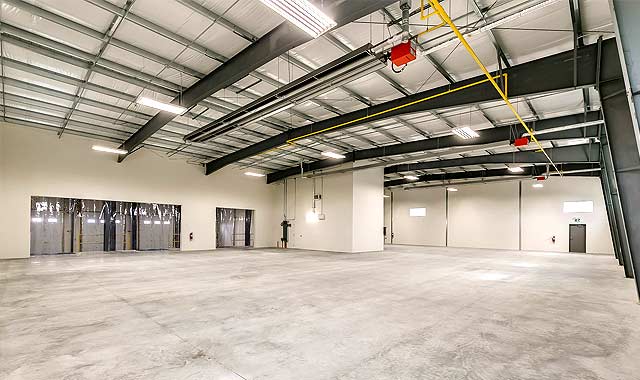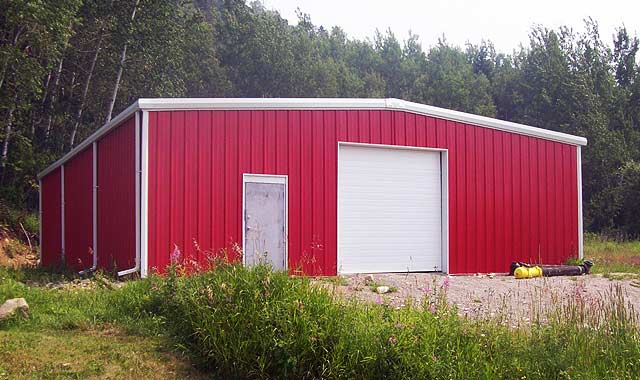
Steel is among the strongest, most durable and most versatile materials available for building construction. With an industry-leading strength to weight ratio, steel offers benefits unparalleled by its wooden and concrete counterparts. You can expect prefab steel structures to last for decades, standing strong against mother nature and requiring little to no maintenance to remain in good repair. With all of steel’s benefits, you’d expect it to also be the most expensive building option. After all, in most industries, the best options are typically the most costly. Steel doesn’t follow that trend. Here are all of the reasons that steel is often your most cost-effective option.
Efficient, Innovative Planning
Prefab steel buildings are designed by engineers using advanced computer software. With these resources, planning is quicker, cheaper and more flexible. We are able to work with you to perfectly match your building to your needs, and then use those plans to manufacture every piece required to bring it to life.
Installation is Faster & Cheaper
Steel is much lighter than other construction materials, so the foundation to support your building will require less concrete. The building itself arrives to the site in ready-to-assemble pieces. These pieces are made to fit perfectly, which means no cutting or altering and very little waste leftover when complete. This process requires less in both labor costs and construction time. In fact, many customers choose to save extra by erecting their buildings themselves.
100% Recycled Material
Unlike other recycled construction materials, steel can recycle without degrading. New steel is constantly being made using recycled steel, making steel one of the most widely available and cost-effective Sbuilding materials.
Little Maintenance Required
Steel buildings are built to last. While wood and concrete degrade, requiring constant, costly upkeep and repair, steel retains its strength for decades. It is resistant to issues like pests, water damage and fire. It is more resistant to damage and corrosion from heavy winds and rain, and is able to withstand heavy snowloads without caving in. All of this adds up to a longer lasting building and more money in your pockets.
Expanding is Easy
Eventually, you’re going to want more space. Whether to accommodate a growing business or a growing fleet of recreational vehicles, plenty of our customers come back asking how easily they can add more space. Luckily, steel buildings are built with expansion in mind. The process of adding space is quick and easy; remove the endwall and add new segments as necessary. Expanding a steel building requires little time, effort and, specifically for businesses, little disruption, saving money and hassle in the process. Why close down for a lengthy construction process every time you outgrow your space? Instead, choose a versatile building that will grow with your needs.
Insurance Costs Go Down
Steel is less likely to require repairs, and insurance companies know this. While you may pay a lot to insure traditional structures, which are vulnerable to fires, hurricane winds, pests and more, you’ll see those insurance costs fall when you choose steel.
They Hold Value
Because of their strength, durability and flexibility, steel buildings tend to hold value better than than wood and concrete. So, your investment is likely to look just as good decades down the road.

Steel structures are known for their unparalleled durability, but can they withstand the toughest tests Canadian weather has to offer?
The subarctic climates of central and northern Canada see temperatures below -20
° C throughout the majority of their extended winters, occasionally falling near the Yukon all time record low -63
° C (-81.4
° F). Snow and ice cover the surface for more than half of the typical year, with snows measuring up to 130 inches over as many as 93 days of snowfall. Winter weather can often come in its extremes. Blizzards bring winds exceeding 40 km/h, reduced visibility, heavy snow and freezing rain. These storms can last anywhere from several hours to several days. Ice storms dump exorbitant amounts of freezing rain, which builds up on rooftops and can cause them to buckle. To withstand heavy snow and ice, you’ll need a building that won’t cave under the pressure. Luckily, steel buildings are designed to handle conditions just like these, with strength and durability to stand through conditions a typical wooden structure simply wouldn’t. Our purlin-braced roof panels are made of 26 gauge AZ55 Galvalume steel with
1¼” inch depth in the corrugation, which adds a great deal of strength to the roof, preventing any risk of cracking, bending or leaking.
But, you still need to plan your design to match your snow load needs and local specifications in order to get the most out of your structure. Snow loads can put in excess of 100 pounds per square foot atop a roof, and the wrong design can lead to sagging, leaking roofs with potential to collapse. Our engineers will work with you to calculate the proper snow load for your needs, taking into consideration factors like necessary roof pitch, wind exposure and ground snow information in your area. With the proper roof pitch, snow and ice will slide off your structure, leaving you worry-free.
While roof pitch will solve most snow and ice issues for you, you can also use several tools to alleviate any remaining snow load; roof rakes with 20-foot handles that can pull snow and ice off of a roof, de-icers that can heat the roof’s surface to melt away snow and ice, and snow guards, which hook onto roof panels to break up snowfall and ice buildup making it more easy to clear.
With steel, you also don’t have to worry about rust from exposure to conditions. Out Galvalume AZ55 steel roofing in highly rust-resistant, and protected by a 40-year limited rust-through perforation warranty.
It isn’t just winter weather that can prove hazardous to a structure. Canadian wind storms can gust at speeds exceeding 90 km/h. Canada also experiences up to 80 tornadoes per year, with winds exceeding 200 km/h. You’ll be relieved to know that, unlike wooden structures, steel buildings are built to withstand even hurricane force winds.
Thunderstorms with heavy rainfall can cause flooding, especially if they arrive as winter snow begins to thaw in spring. With wooden structures, flooding is not only more likely as wood easily corrodes and rots, but it can leave water damage and moisture, which develops into mold and mildew. Steel buildings don’t have this issue, with quality roofing and sturdy walls that won’t leak and won’t retain moisture.
Hail storms, which commonly occur as often as 10 times per year between May and October, pelt walls and rooftops with hailstones that can be as large as grapefruit. For wooden surfaces, the damage can be catastrophic, especially to exterior paint, which will likely require at least an annual coat to retain its aesthetic appeal. Our steel buildings offer polyester baked-on paint with a 40 year warranty against cracking, peeling and blistering, because we’re sure our paint job will withstand the elements for years to come without any touch ups required.
Finally, lightning strikes can spark wildfires, like the ones most recently seen in British Columbia, where more than 860 fires burnt nearly 5,000 kilometers of land, damaging property and risking lives with an intensity that was visible from space. For owners of wooden structures, fire marks a costly end to businesses, homes, storage and more. But with steel, your need to worry about wildfire disappears entirely.
So, yes, steel buildings pass every test Canada has to offer. So, call today and speak with our experts about designing the right building to suit your specific needs.

As your business begins to grow, you may begin to feel the walls of your, once perfectly sized, space closing in on you and your company’s potential. It’s inevitable for any business fortunate enough to thrive, and it’s a fantastic problem to have. Choosing the right way to expand can be difficult, and making the wrong choice can cause a lot of unnecessary spending and hassle. Luckily, there is a universal solution for businesses of every type and size; prefabricated steel buildings. Businesses across Canada are making the smart choice and opting for steel. From landscaping companies to churches, auto shops, gyms and corporate offices, steel offers the flexibility and affordability to accommodate the needs of any business, large or small. Here are a few reasons why steel is the right choice for you.
If you are currently renting office space, like many small businesses are, you’re probably sick of making payments on another person’s investment. Or maybe you own your own building, but you’re limited by its small size and need to move into something larger. Either way, steel is the answer you’re looking for. When you own a steel building, you’re investing in the future of your company. Not only will these permanent structures appreciate your property value, they’re easier to expand and modify than traditional wood or concrete buildings, so your space can grow with the business, and you won’t ever have to move again. It’s worth noting that these buildings are fully customized to your specifications so you won’t ever have to settle for a less-than-perfect existing building. Prefabricated steel structures put you in the driver seat, allowing you to choose from modifications like roll-up doors, insulation, lighting, window size and placement, skylights, gutters and sectional doors.
The DIY nature of assembling prefabricated steel buildings allows for quick, cost-effective business expansion for small businesses and tight budgets. All of the heavy lifting is completed by our staff of highly experienced building designers. They will design your building to meet your needs and specifications, and every kit comes complete with their instructions on how to perfectly fit all of the components together. Your building will require no cutting or modifications to erect, and will go up quicker than any woof or concrete construction project, saving you valuable time to get your business up and running sooner rather than later.
Steel is among the most durable, long-lasting and sustainable materials available for building construction. It withstands weather conditions and wear and tear better than concrete and wood framed buildings can. The non-combustible nature of the material reduces both risk and costs to insure it. Steel also happens to be the most low-maintenance building materials available, so keeping your building like-new will be as easy as a few annual checks. On top of all this, you’re protected by Olympia’s comprehensive warranties, so you won’t ever have to worry again.

One of the benefits that comes with choosing a steel building is that when compared with wood structures, steel is very low-maintenance. In fact, steel buildings are often said to be maintenance-free. Wood requires sealing and repainting every year because wood walls and roofs are highly susceptible to wear and tear from weather, wind, moisture and pests. Wood will rot, crack and leak, and without regular maintenance, can require costly repairs and replacements. On the other hand, steel is durable enough to retain its performance and its aesthetic appeal will very little maintenance required. The paint on a steel building can last more than three decades, so you won’t need to add a fresh coat every year like you would with a wood structure. Weather and wind have little to no effect on steel. Moisture issues are less likely because leaks don’t occur without the rot and cracking that wood buildings experience. Pests aren’t an issue without wood to infest. Steel roofing doesn’t require shingle replacements and doesn’t wear down as easily from the weight of snow and ice. Steel is just a more durable material than wood, so you’ll save time and money not having to constantly deal with upkeep. Plus, steel buildings come with warranties that cover roof panels, silicone-polyester coatings, girts, purlins, C-sections, fasteners, frames and I-beam construction. This doesn’t mean you should neglect your building entirely, but it does mean that you can rest assured that following just a few simple upkeep steps will help you keep your building in excellent condition for a long time. Note that maintenance frequency will vary by geography, as some areas will experience more storms, humidity, snow or pollution. In most cases, an inspection at the end of fall and start of spring, as well as following any instances of inclement weather, will suffice to keep your steel building in great shape.
For any new structure, make sure to clean up after installation. Be sure no loose screws or scraps of metal are left lying around, as they can scratch and damage surfaces. Over time, occasionally check for loose screws and tighten them. Use a pressure washer to spray leaves, dirt and dust from exterior surfaces and overhead doors. Steel isn’t likely to corrode from weather effects like these, but an occasional wash can still help, if only to retain the aesthetics of a brand new building. Remove debris from gutters to avoid issues with blockages and downspout backups. Standing water can begin to corrode and rust metal. After the first rain on a new structure, walk the perimeter of your building and check how water is draining. Adjust drainage for any pooling you find occurring. A careful sweeping of debris from the roof can also be beneficial, so long as you do so safely and cautiously. The same goes for snow and ice in the winter, for which you can use a specially designed snow rake to reduce the load on the roof before it becomes too heavy. Be sure to check seals and weather stripping on doors and windows, lubricating tracks as it is necessary. Once a year, check insulation for moisture and damage and replace as necessary to avoid mold and loss of temperature control.
For any questions about maintaining your steel structure, call and talk to our experts at 1-888-449-7756.

Steel is the most important and widely used building material there is. It also happens to be the most recycled material that there is. Approximately 650 million tons of steel are recycled yearly, which outpaces all other materials combined. Steel is 100% recyclable, and new steel can be made from 100% recycled steel. There is also no limit to the number of times that steel can be recycled because it retains all of its properties without losing quality. This infinite recycle potential makes steel the premier “green” construction material.
The recycling process is straightforward and simple. Scrap steel is sent to steel refineries where it will be recycled. The steel is analyzed to assess the alloy makeup. Tin is removed using reverse electroplating and then the steel is melted into metallic liquid iron using electric arc furnaces and used to create new steel. The electric arc furnace has largely replaced the blast furnace in steel production. This shift has contributed to a revolutionary change in the steel making process that is roughly 60% more efficient than it was 50 years ago. The electric arc furnace, or EAF, has the ability to use recycled steel and electricity while consuming far fewer resources. Blast furnaces require fifty times more coal and twelve times more limestone than the electric arc furnace.
Each successive recycle of steel saves both energy and raw materials, including iron ore, coal and limestone. For every 1,200 pounds of steel created, steel recycling is responsible for conserving 1,600 pounds of coal, 3,000 pounds of iron ore and 250 pounds of limestone.
Recycling steel also conserves landfill space. Landfills have increased in size over the past several decades, but recent estimates show that material recovery and recycle could reduce landfill space by 4,000 acres per year. Recycling also reduces greenhouse emissions. Recycled materials reduce energy use and can be burned in place of fossil fuels. For example, making steel cans from recycled steel rather than starting from scratch with virgin materials reduces the total energy usage by upwards of 75%. This is the reason why most steel currently in use contains at least 20% recycled scrap content. Scrap is absolutely essential to the efficient production of new steel. Over the past 30 years, more than a billion tons of steel have been scrapped and recycled. During that time, the steel industry has been able to effectively reduce its energy footprint by nearly one-third.
Recycling construction materials has economic benefits, as well. The recycling industry creates more jobs than landfill disposal, which helps fuel local economies. It is also helps drive down costs associated with construction projects, like waste disposal costs, transportation costs and the costs of purchasing new materials, allowing companies to create more jobs. Companies that adopt policies that embrace steel recovery and recycle also become more able to comply with modern construction standards and rating systems, and tend to see positive changes in their public perception.




